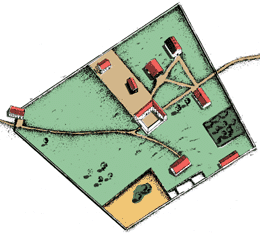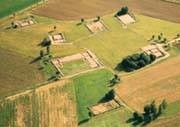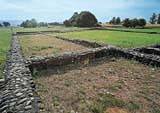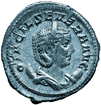The Roman Estate Büßlingen
One of the largest estate-arrangements laid open in South-Germany

(The reconstruction shows the estate-layout with nine stone-buildings and the path of the estate.)
Not only are the medieval municipalities of the Town Tengen, the Town Tengen-Hinterburg or of the Town Blumenfeld characterizing the landscape of the Hegau Alb, the Roman Estate also is a sign of a long history of settlement in this marvellous volcano-landscape.
The Roman Estate Büßlingen lies along the road Singen - Storzeln -Büßlingen. The foundation-walls of the Estate are almost completely restored. It may be supposed that the directly westerly bordering area called "Hochstraß" points to a passing Roman road. 1/6 of the Estate-area, which covers 5,4 hectares in all, is excavated. So far the Estate is the second largest layout of this kind in whole Baden-Württemberg and Bavaria. 10 excavated stone-buildings in all can be visited there.
Usually, the "Villa Rusticae" were built near a small brook or a source .There were larger places close to them and - as far as possible - busy roads. The area of the Estate was enclosed by a low wall. Housing- and economic-buildings formed a group around the main-building. Unlike today, agriculture was the most significant and most important branch of industry in Roman times. The population of towns and villages as well as army-bases were provided with the agricultural products of the countless estates.

The main building is centrally located in the area of the Estate.

Along its western, southern and eastern front 10 rooms altogether line up; two of them were equipped with underfloor- and wall wall-heating. A partly covered inner-courtyard with almost 600 m² forms the largest part of the main-building.
The temple is opposite the upper chamber.

The bath-building belonging necessarily to a villa is closely along the encirclement-wall to the south. The changing room and the cold bath with a cold-water-basin are in the western part of the building; the tepid-bath and the hot-bath are in the eastern part. It was heated by a pre-stored boiler room. It is amazing how similar the former heating- and heat systems to today's heating engineering and heat technologies practised according to new knowledge are.
Owing to finds of coins and ceramic the year of foundation around 75/80 AD seems quite sure. The end of the Estate can - by the help of a comprehensive coin-treasure containing 99 coins found in one building - be established for 263 AD at the earliest.
